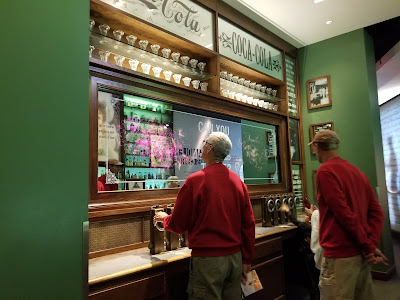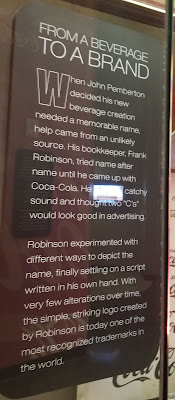#74 The World of Coca Cola
Friday Oct. 25, 2019
The Coca-Cola Museum used to draw the most people, then
the Georgia Aquarium moved in next door.
Lots of field
trip groups were heading for the Aquarium, glad they weren’t going to Coke.
This wall greeted visitors. You could even get a free small can of a
coke product.
The Loft surrounded you with Coca-Cola artifacts from its
beginning to now, and from all around the world. It looked like this area house
millions of artifacts. A gentleman here
gave us a brief intro to the museum.
Then we went into the theater for another presentation.
These recycling bottles were all over the museum so
people could recycle the free cans of pop when they were finished.
Around the main lobby were these highly decorated
bottles. Apparently a different design
is created for the Milan Fashion Week each year.
Coca Cola and sports with Mean Joe Green.
A very scruffy polar bear posed with visitors for photo
ops. We passed.
We started the tour through the vault.
Our trolley tour guide Sally told us that John received a
nasty saber wound in the chest during the Civil War in defense of Georgia. The wound led to a morphine addiction. In an
effort to get off the addiction, John a pharmacist by trade, invented a
beverage that could help him. None of
this was mentioned in the museum. John
died in 1888 at the age of 57.
John experimented with many concoctions before he found
the formula for Coca-Cola.
One interactive display has you guessing how much of each
taste makes a coke. Derrille tried his
hand and got a Not Bad response.
This was the pharmacy where John worked.
.
Asa Chandler paid $2300 for the formula and all rights to Coke.
The Coca-Cola formula remains a well-guarded secret. He built his headquarters in Atlanta.
Chandler ‘s family sold the company to $25 million to
Robert Woodruff in 1919.
The Coke’s rise in popularity, others tried to copy it
taste. The Coke company calls these
people impostors.
A variety of bottling companies were producing the
beverage. Woodruff wanted it to be
distinctive so he put out a contest to create a bottle with 2 specific
attributes: that it could be recognized by touch in the dark, or when lying
broken on the ground.
Woodruff wanted to market his product to reach more
people.
Woodruff followed Chandler rule to keep the formula a
secret.
I’m not sure what this means. But we were led to believe that the formula
is locked in this vault. Could be….a
small child got close to the glass rail and the rep in this room scooted him
back and said if he got closer all kinds of alarms would go off. The vault is really silver. Red lights were flashing when I took this photo.
That led to a whole group of myths and legends over the
years.
The next section was called Milestones of
Refreshment. It shows Pemberton mixing a
batch of his special syrup.
Most drug stores in this era had soda fountains. My uncle was a pharmacist, and had a great
granite soda counter in the mid-1900s.
Have you ever wondered where the name came from? Well John’s bookkeeper Frank Robinson came up
with it, and the striking logo is Robinson’s own penmanship of Coca-Cola.
Coca-Cola through the years.
From 1896 to the early 1900s porcelain syrup urns were
given to stores that ordered more that 100 gallons of Coca-Cola syrup in year.
Coca-Cola goes global.
This truck was used by a family in Argentina so it could get through the
narrow streets and reach more people.
In 1899 Chandler was skeptical about the concept of bottling the beverage. So he sold the bottling rights to Benjamin Thomas and Joseph Whitehead for one dollar! The same system is in place today. Bottlers buy the beverage concentrate and then add sweeteners and water. Then they package the drinks and distribute to the retailers.
Ads were matched with activities at work, play, in music, food, travel, and movies.
Woodruff wanted to put Coca-Cola “within an arm’s reach of desire” and the vending machine was born. There is even a vending machine for space.
Next came the handy 6 pack and cans for space.
The Bottle Works give a behind the scenes look at a bottling process. The process starts with cleaning. The water is treated. The syrup tank mixes the concentrate with sweeteners and water.
The Blender mixes the concentrate, sweeteners and water.
It measure the accurate proportions of each, and then adds CO2.
Of course a Q and A department helps control the quality of the product.
Before bottles can be filled the bottles must be pressurized.
The bottle inspector checks the bottles before they move
on to be rinsed.
The Packaging robot is next. It puts the empty bottles in production to be filled and then stacks the filled bottles as they come off the line. The demo here runs significantly slower than in real time.
The conveyor belt runs near the ceiling all around the
museum.
In WWII Woodruff had 64 complete bottling plants shipped
to locations in Europe, Africa and the Pacific.
Coca-Cola’s Olympic torch relay support began in 1928. The company has been a continuous Olympics supporter.
This exhibit blew me away. I did not know that Coca-Cola has over 500 brands, and that 20 brands on the global level bring in $1 billion annually. WOW! I was surprised that Coca Cola
By spinning the arrows around the circle, you can see when the product was brought on line.
The Perfect Pause theater allowed visitors to enjoy the
best of Coca-Cola advertising throughout the years.
The Pop Culture section shows how fans made Coca-Cola a brand icon of the pop culture.
The Real Thing campaign was launched 50 years ago.
The hill top commercial spoke to peace, harmony, optimism and unity in a discontented world. Everyone viewing this was singing along to "I liked to teach the world to sing". (Which really starts " I'd like to build the world a home:.
The Coca-Cola Portrait Wall tells how Coca-Cola benefits people and communities around the world. I was impressed.
The "Taste It "room has international tasting stations. The stations represent a continent: North America, Latin America, Asia, Africa, and Europe.
Each station has a fountain tap with 8 spigots on the four sides of the stations. Not all sides offer the same flavors. You can try anything you like.
Or you can mix it your way! When you have your fill, like all museums you
exit through the gift shop.
Coca Cola does inspire feelings of peace and happiness throughout
the entire museum. I am also impressed
by what we learned on the trolley tour about coke’s park in helping the city
with any need, big ready to roll on any disaster and helping people not only in
the US but around the world. It is reassuring to hear of all the great things a
big corporation does to help people.
Tomorrow: Charleston, SC















































































































































No comments:
Post a Comment